
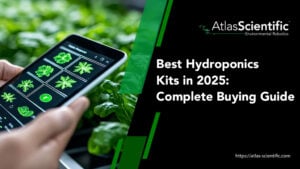
Best Hydroponics Kits in 2025 – A Complete Buying Guide
Hydroponics has revolutionized the way people grow food, offering soil-free methods that deliver nutrients directly to plant roots in water-based systems. But success in hydroponics
# Type at least 1 character to search # Hit enter to search or ESC to close

No products in the cart.

No products in the cart.
Product Categories
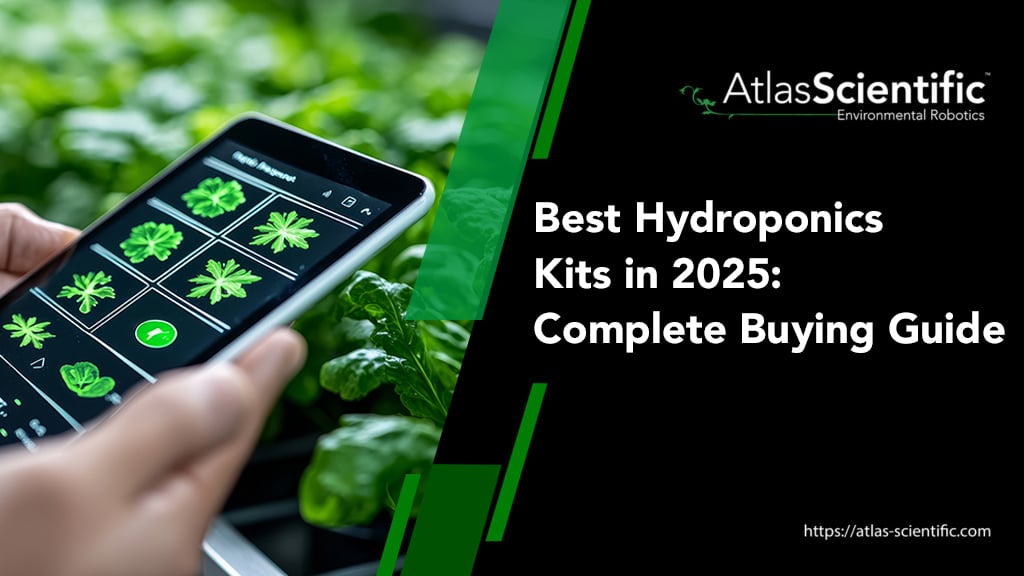
Hydroponics has revolutionized the way people grow food, offering soil-free methods that deliver nutrients directly to plant roots in water-based systems. But success in hydroponics relies on precision—plants thrive only when nutrient concentrations, pH balance, and water conditions remain within tight ranges.
That’s why hydroponic monitoring kits have become essential tools for growers at every level. Instead of guesswork, these devices provide real-time measurements of critical parameters like pH, electrical conductivity (EC), total dissolved solids (TDS), and temperature. And with the integration of Wi-Fi and cloud monitoring, growers can now check their systems anytime, anywhere.
In this article, we’ll take an in-depth look at four of the most popular hydroponic monitoring kits available today:
We’ll explore what each offers, who they’re best suited for, and how they compare side by side.
Unlike soil-based gardening, hydroponics removes the natural buffer that soil provides. This means water quality must be carefully managed:
Advanced monitors add even more parameters, like dissolved oxygen, oxidation-reduction potential (ORP), or salinity, which can further optimize plant health.
Traditionally, growers tested these values with handheld meters. But today, Wi-Fi-enabled hydroponic kits allow for continuous, automated monitoring—often with cloud integration and real-time alerts sent to your phone.
Wi-Fi integration is changing the hydroponics world. With remote monitoring, growers can:
For commercial growers, this reduces labor and prevents costly mistakes. For hobbyists, it provides peace of mind and helps them learn more about their systems.
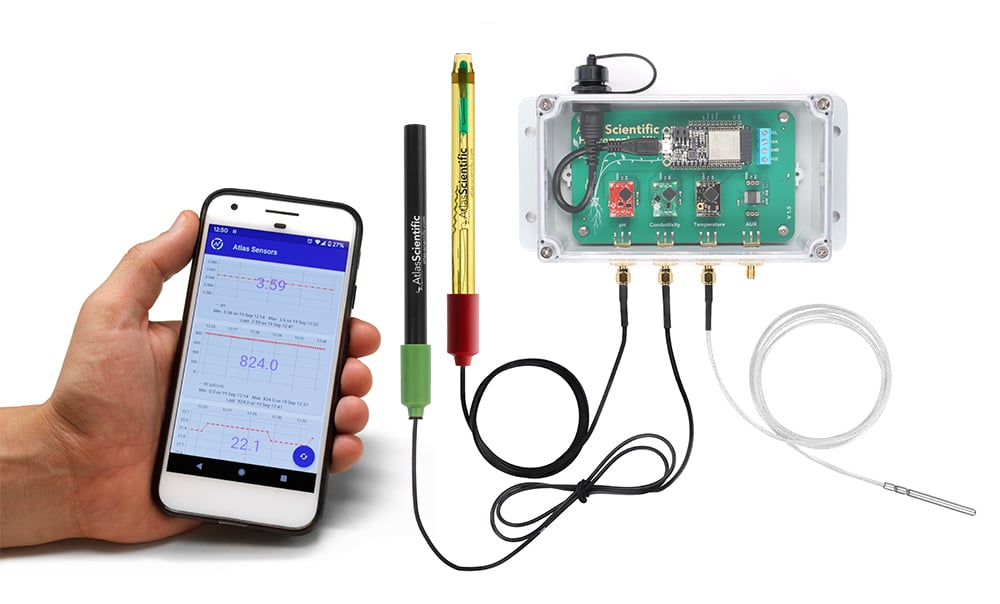
The Atlas Scientific Wi-Fi Hydroponics Kit packs a number of standout features that make it a compelling choice for growers who want real-time insight and control over their nutrient systems. First, it integrates three essential sensors—pH, conductivity (EC), and temperature—into one unified kit, giving you a clear and continuous view of your solution’s chemistry. Because the pH and EC measurements are automatically temperature compensated, the readings remain accurate even as your water temperature fluctuates.
One of the most powerful qualities of this kit is its Wi-Fi connectivity and remote monitoring capabilities. The device uploads data to the cloud (via ThingSpeak), enabling you to check your system’s pH, EC, and temperature from your phone, tablet, or computer—no need to be physically present. This level of remote oversight is especially valuable for hydroponic systems that must remain within tight tolerances and for growers who want to intervene quickly if something drifts out of spec.
From a design standpoint, the Atlas kit is smartly engineered. The kit uses a microcontroller (ESP-based) platform, runs on 5V power, and supports I²C-based sensor modules, making it relatively flexible for integration with automation or IoT systems. The enclosure is pre-drilled, wall-mountable, and features compartments that help electrically isolate the sensor modules—helping to minimize interference between circuits.
Also worth noting is the community around the kit. Many users report that the pH probe included is of “lab-grade” quality, capable of long-term immersion, and able to hold calibration for months. Because the Atlas ecosystem uses modular circuits (EZO modules), you can replace or upgrade individual sensors (e.g. switch in a higher-end EC probe) without needing to swap the entire system. (However, it’s wise to be aware of calibration schedules and electrode maintenance.)
You can also connect this kit to the Atlas Scientific line of dosing pumps, which can be setup to automatically dose out nutrients to the water, when needed.
That said, no system is perfect, and there are a few caveats. Some users have reported occasional sensor drift or erratic readings—often traceable to power instability, Wi-Fi interference, or probe condition. But if maintained well, the Atlas Scientific kit gives you a robust, modular, and connected solution for monitoring your hydroponics system at a level that would otherwise require piecing together discrete components and software yourself.
Let’s examine how it compares to other Wi-Fi hydroponic kits in sensor precision, setup, cloud connectivity, and long-term reliability. Whether you’re monitoring a single reservoir or a fully automated greenhouse, choosing a lab-grade kit over a budget system ensures consistent nutrient readings and healthier crops.
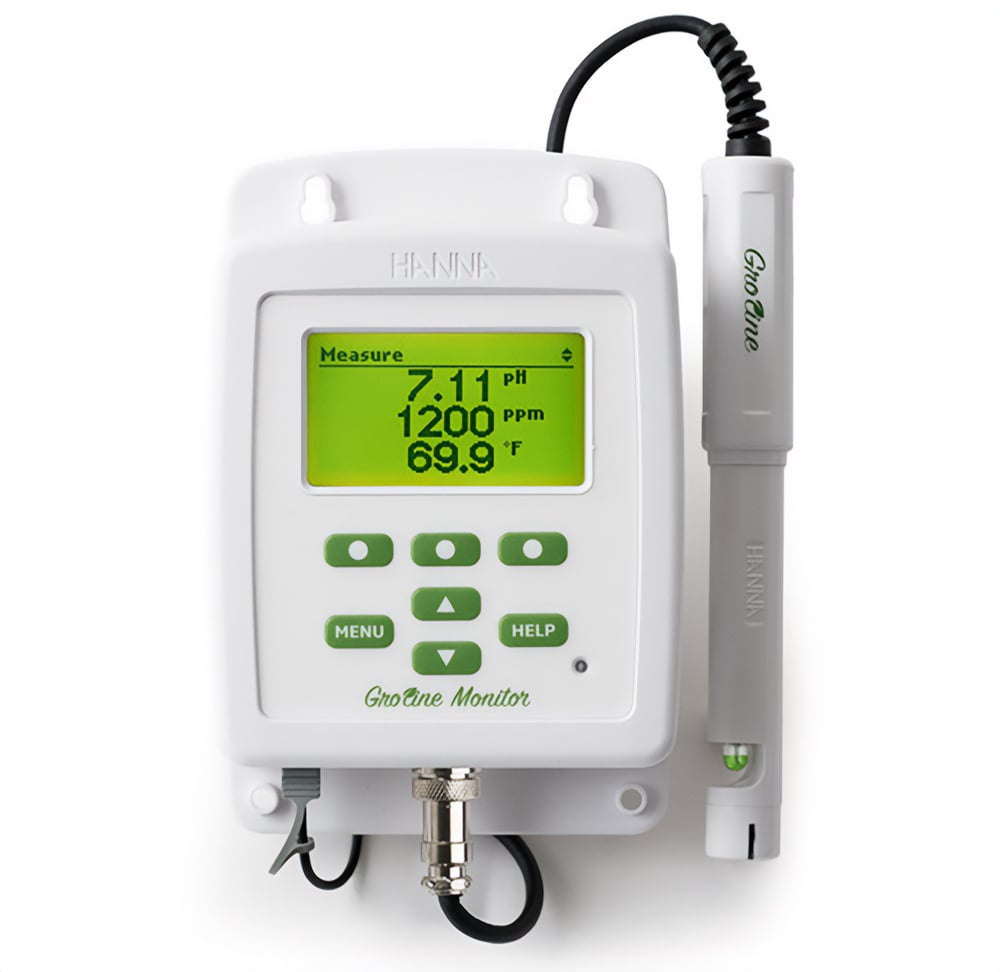
| Atlas Scientific Wi-Fi Hydroponics Kit | Hanna GroLine Monitor for Hydroponic Nutrients (H1981420) | |
|---|---|---|
| Price | Approximately $550 USD | Approximately $480 USD |
| Parameters Monitored | pH, Conductivity (EC), Temperature | pH, Conductivity (EC or TDS), Temperature |
| Connectivity | Built-in Wi-Fi; uploads data to ThingSpeak cloud; remote monitoring via phone, tablet, or PC | No Wi-Fi, or connectivity available. |
| Display | No built-in display; data accessed remotely | Large backlit LCD display for real-time monitoring |
| Power Source | 5V via micro USB | Mains powered (110–240 VAC) |
| Mounting | Wall-mountable with pre-drilled case | Wall-mounted or hung with included mounting hardware |
| Calibration | Auto temperature compensation for pH and conductivity; manual calibration required for pH probe | No calibration required for conductivity and temperature; pH probe requires regular calibration |
| Sensor Ports | Three electrically isolated slots for pH, conductivity, and AUX sensors | 3 sensors combined in a single rugged probe body. |
| Additional Features | Modular design; compatible with Atlas Scientific EZO sensors; customizable with Arduino IDE | High/low alarms for pH, temperature, and conductivity; non-volatile memory retains settings during power loss |
| Ideal Users | DIY enthusiasts; growers seeking customization and integration with other systems | Commercial growers; users preferring a simplified plug-and-play solution. |
The Hanna GroLine Monitor for Hydroponic Nutrients takes a more traditional approach: everything you need is right on the device. Its large, backlit LCD display shows pH, EC/TDS, and temperature readings at a glance. Unlike the Atlas Scientific kit, it also includes built-in alarms that warn you if readings drift out of your chosen range, making it highly practical for everyday growers.
The monitor uses a 3-in-1 pre-amplified probe, which simplifies setup and installation. You mount it in-line or submerge it in your nutrient reservoir, and it continuously measures conditions without the need for complex integration or software.
However, it lacks Wi-Fi or cloud connectivity. That means it’s best suited to growers who are physically present in their grow area, rather than those who want remote monitoring.
Best For: Growers who prefer a simple, standalone display without relying on Wi-Fi.
Limitations: No remote monitoring or sensor expandability.
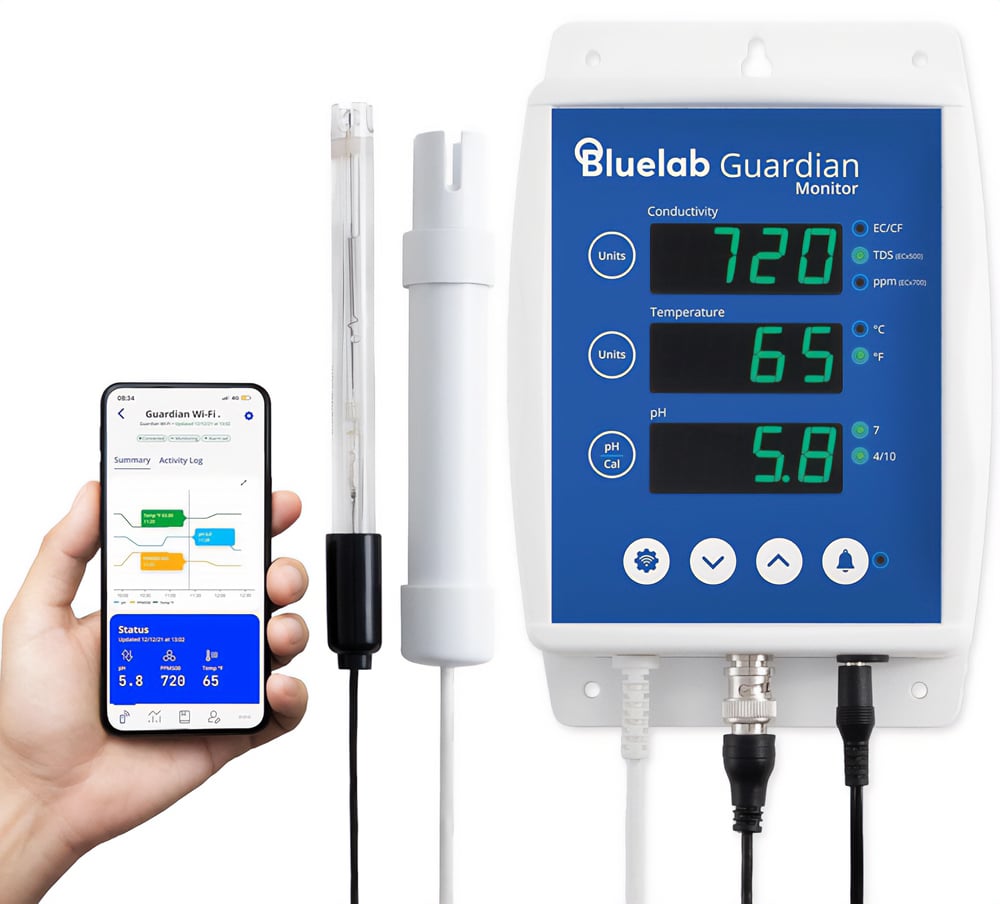
| Atlas Scientific Wi-Fi Hydroponics Kit | Bluelab Guardian Monitor with Wi-Fi | |
|---|---|---|
| Price | Approximately $550 USD | Approximately $495 USD |
| Parameters Monitored | pH, Conductivity (EC), Temperature | pH, Conductivity (EC), Temperature |
| Connectivity | Built-in Wi-Fi; uploads data to ThingSpeak cloud; remote monitoring via phone, tablet, or PC | Built-in Wi-Fi; compatible with Edenic app for remote monitoring and alerts |
| Display | No built-in display; data accessed remotely | 7 segment LED display for real-time monitoring |
| Power Source | 5V via micro USB | Mains powered (110–240 VAC) |
| Mounting | Wall-mountable with pre-drilled case | Wall-mounted or hung with included mounting hardware |
| Calibration | Auto temperature compensation for pH and conductivity; manual calibration required for pH probe | No calibration required for conductivity and temperature; pH probe requires regular calibration |
| Sensor Ports | Three electrically isolated slots for pH, conductivity, and AUX sensors | Two probe inputs for pH and conductivity |
| Additional Features | Modular design; compatible with Atlas Scientific EZO sensors; customizable with Arduino IDE | High/low alarms for pH, temperature, and conductivity; non-volatile memory retains settings during power loss |
| Ideal Users | DIY enthusiasts; growers seeking customization and integration with other systems | Commercial growers; users preferring a plug-and-play solution with robust support |
The Atlas Scientific Wi-Fi Hydroponics Kit and the Bluelab Guardian Monitor Wi-Fi both monitor pH, conductivity (EC), and temperature, but they serve different types of growers. The Atlas kit excels in flexibility and expandability, with multiple sensor ports and cloud integration via ThingSpeak for remote monitoring, data logging, and automation—making it ideal for advanced growers or researchers.
The Bluelab Guardian Monitor Wi-Fi emphasizes ease of use and reliability, featuring a bright LED display, built-in high/low alarms, and Wi-Fi access through the Edenic app. It’s mains powered and factory-calibrated, perfect for growers who want a simple plug-and-play solution with on-site and remote monitoring.
Best For: Growers seeking a straightforward solution without complexity or technical integration.
Limitations: Limited to three parameters and not expandable.
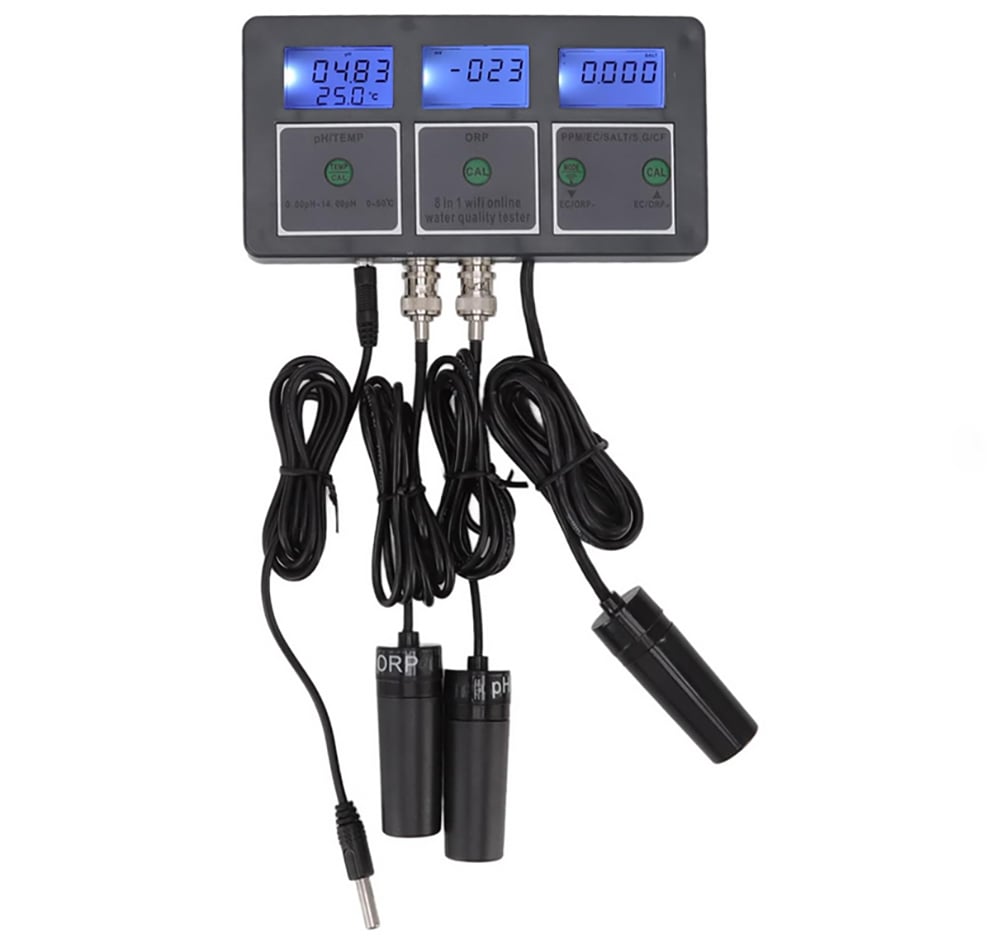
| Atlas Scientific Wi-Fi Hydroponics Kit | HW PH-W218 Wireless Monitor | |
|---|---|---|
| Price | Approximately $550 USD | Approximately $45 USD |
| Parameters Monitored | pH, Conductivity (EC), Temperature | pH, ORP, Conductivity (EC or TDS), Temperature |
| Connectivity | Built-in Wi-Fi; uploads data to ThingSpeak cloud; remote monitoring via phone, tablet, or PC | Built-in Wi-Fi; compatible with an app for remote monitoring and alerts |
| Display | No built-in display; data accessed remotely | 7 segment LED display for real-time monitoring |
| Power Source | 5V via micro USB | Mains powered (110–240 VAC) |
| Mounting | Wall-mountable with pre-drilled case | Wall-mounted or hung with included mounting hardware |
| Calibration | Auto temperature compensation for pH and conductivity; manual calibration required for pH probe | Frequent calibration is strongly recommended. |
| Sensor Ports | Three electrically isolated slots for pH, conductivity, and AUX sensors | Four probe inputs for pH, ORP, EC and temperature |
| Additional Features | Modular design; compatible with Atlas Scientific EZO sensors; customizable with Arduino IDE | High/low alarms for pH, ORP conductivity, and temperature. |
| Ideal Users | DIY enthusiasts; growers seeking customization and integration with other systems | Hobbyists, first time hydroponic growers. |
The Atlas Scientific Wi-Fi Hydroponics Kit and the HW PH-W218 Wireless Monitor both track pH, conductivity (EC), and temperature, but they serve different needs. The Atlas kit is designed for advanced growers and researchers, offering high-precision sensors, automatic temperature compensation, cloud integration via ThingSpeak, and expandability for additional probes. It’s ideal for setups that require remote monitoring, data logging, or automation.
The PH-W218 Wireless Monitor is a budget-friendly, all-in-one solution that measures multiple parameters—including pH, EC, TDS, salinity, ORP, and temperature—and displays them on a large digital screen. With mobile app connectivity, it’s perfect for hobbyists or small-scale growers who want real-time monitoring without the complexity of advanced setups. Unfortunately, it does require frequent re-calibration of its probes to maintain accuracy.
Best For: Beginners or hobbyists looking for an affordable, all-in-one water monitor.
Limitations: Accuracy can vary across parameters, and it’s not specialized for hydroponics.
When deciding which hydroponic kit is right for you, consider the following:
Hydroponic monitoring kits have evolved from basic handheld meters to sophisticated Wi-Fi–enabled systems, offering growers a range of options to suit different needs. For budget-conscious growers seeking multi-parameter coverage, the PH-W218 is ideal, while the GroLine Monitor provides a simple, reliable, display-driven solution. Those who value brand reliability, continuous monitoring, and remote access may prefer the Bluelab Guardian Wi-Fi, whereas the Atlas Scientific Hydroponics Kit is best for users needing lab-grade precision, expandability, and automation integration.
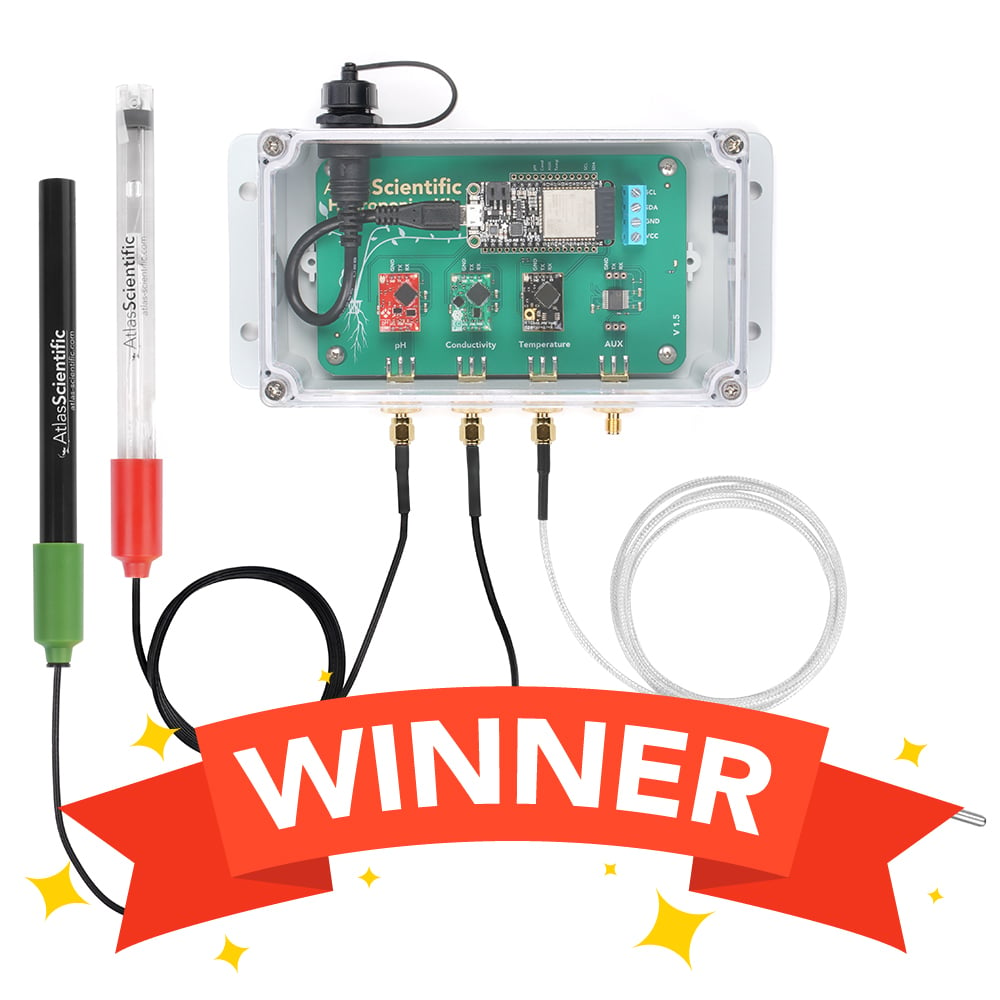
The Atlas Scientific Wi-Fi Hydroponics Kit stands out as a superior choice for hydroponic monitoring due to its advanced features and flexibility. It offers real-time remote monitoring of pH, conductivity, and temperature via ThingSpeak, allowing growers to track their system’s parameters from anywhere. The kit includes high-quality sensors with automatic temperature compensation, ensuring accurate readings. Its modular design supports future expansions, accommodating additional sensors or automation systems
Choosing the right monitor helps maintain stable water chemistry, reduce plant stress, and optimize yields, ensuring a healthier, more productive hydroponic system. If you would like to learn more about hydroponic systems or what probes & sensors are best for your hydroponic growing environment, contact the world-class team at Atlas Scientific today for expert advice.

Hydroponics has revolutionized the way people grow food, offering soil-free methods that deliver nutrients directly to plant roots in water-based systems. But success in hydroponics

To make an NFT hydroponic system, put together sloped grow channels, a reservoir, a water pump, and net cups. Add a nutrient solution and make
Notifications